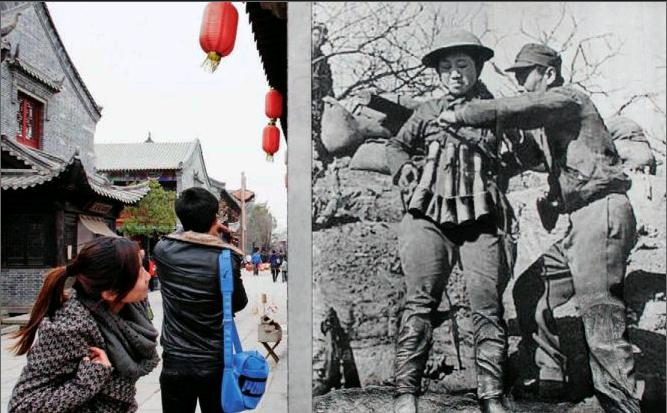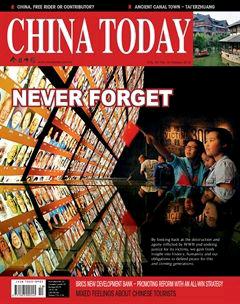Ancient Canal Town–Tai’erzhuang
By+staff+reporter+ZHOU+LIN

Economic Boom
Strolling around Taierzhuang, you can be fooled into thinking you are in a southern Chinese riverside town; myriad ponds are interlinked and eventually fl ow into the age-old canal forming the water system. These water passages are the veins of the town. With rowing boats as the main mode of transport, Taierzhuang is well deserving of the moniker,“Venice of the Orient.”
In ancient times, Taierzhuang was frequently paralyzed by the flooding of the Yellow River owing to its geography, so its inhabitants would build their homes on terraces. To manage the threat of high waters, local authorities installed locks along the canal. During the Ming (1368-1644) and Qing (1644-1911) dynasties, eight locks were set up along the Taierzhuang stretch of the canal. Passing through all these locks took several months in the flood season. Hence, merchants on their way through had no choice but to stop over in Taierzhuang, which, consequently, helped the town grow into a prominent business center along the canal.
During the reign of Qing Emperor Kangxi (1661-1722), there were 60,000 inhabitants and over 160,000 migrants in Taierzhuang ancient town. But it was during the ruling periods of Qing emperors Qianlong and Jiaqing (1736-1820) that the town witnessed its heyday. It was regarded as a hub of road and water transport as well as a center from which commercial cargo was distributed to surrounding provinces. Every year 112,000 tons of grain were transported through the waterways here and 7,700-plus barges passed through the locks, creating a vista of “merchant boats forming long queues along the river, lighting it up at night with their myriads of lamps and enlivening the air with sailors songs,” as recorded in the county annals.
Walking along the fl agstone roads, a large number of old docks and mooring ports come into sight, which are well preserved as cultural relics. Architecture of various styles can be found throughout the town today, including the white walls and black tiles style of Anhui, the courtyards of northern China, typical Suzhou gardens and even a Westernstyle Gothic cathedral.
Through the extensive exchanges of people, commodities and information in history, the town developed into a melting pot of Eastern and Western cultures as well as North and South China civilizations. The towns different architectural styles exist in perfect harmony: The dwellings typical of Shandong, Anhui and Fujian provinces stand back to back with buildings of distinct European features; and local religious architecture spans all major world faiths, including Judaism, Christianity, Islam, Buddhism, Taoism and Confucianism. The first joint stock enterprise in Chinese history, Chung Hsing Coal Mining Co., contributed to the establishment of Taierzhuangs rail network, thus attracting foreigners, who introduced Western civilization into this historical and cultural town.endprint
Post-war Vitality
Taierzhuang has strategic signifi cance in Chinas battle history. To safeguard the waterway transport system, the Ming Dynasty established an inspection offi ce in Taierzhuang in 1606. In 1647 a troop was dispatched there to guard the town and ensure the safety of merchants. They made it a strategic center– the south gate of Shandong Province and north gate of Xuzhou (Jiangsu Province) – as well as a natural defense for the capital city, Beijing.
In the spring of 1938, the astonishing Battle of Taierzhuang, later hailed as Chinas first major victory in the War of Resistance against Japanese Aggression (1937-1945), broke out and left the town in ruins with bullet-ridden, blood-stained walls. The steel helmets of fallen Japanese invaders and one-inch-thick fragments of hand grenades floated on the bloodied water of the canal. At present, 53 WWII sites, still bearing the scars of the war, and abundant cherished photos taken by war correspondents are preserved in Taierzhuang. While it is now over 70 years since the battle, the memory of war still seems fresh. The old town walls, riddled with bullet holes – 375 of them over one square meter at one point – serve as a constant reminder.
Li Tsung-jen, the Fifth War Zone commander of the Kuomintang, recorded in his memoir that Taierzhuang was chosen as the site of the decisive battle against the Japanese army, largely because 6,600 buildings in the town were strong enough to serve as shelters for Chinese soldiers.
The old town of Taierzhuang was rebuilt in 2008. For this mission, the restoration team looked through more than 30 local chronicles, over 300 historical materials relating to the canal and 2,000-plus battle-related documents, with more than 380 old pictures of Taierzhuang and videos. They visited 27 elderly witnesses of the wartime period, and invited 130 experts to determine the towns various architectural styles. Archaeological excavations were also conducted at ruins of canal locks, piers and the Mt Tai Temple, first built in the 16th century.
Rejuvenation of Intangible Cultural Heritage
The rejuvenation project has breathed new life into the ancient town. In 2012, an intangible cultural heritage park was built in Taierzhuang. Currently, there are more than 150 national intangible cultural heritage items in the park, such as Liuqin
Opera, Yunhe Dagu (a folk story-telling and singing art with drum accompaniment along the Grand Canal) and Shadow Play, drawing in tourists from far and wide.endprint
A boat-shaped street surrounded by water, evoking a ship on the ocean, is a distinctive part of the ancient town. According to records, tens of thousands of barges passed through the Taierzhuang canal annually at its peak. All the wooden gates of buildings along the boat-shaped street are carved with boat patterns, 468 in all, blessing the passing fleets. Halfway down the street stands a stage for opera performance called Houle Pavilion, which features in a famous verse by the revered poet Fan Zhongyan (989-1052).
Folk artists were performing Liuqin Opera when the journalist visited. Liuqin Opera, storytelling in the local dialect with a drum accompaniment, got its name from a musical instrument shaped like the leaf of a willow (liu in Chinese). This form of opera originated in southern Shandong and was later popularized in neighboring northern Jiangsu Province along the Grand Canal.
Yunhe Dagu can be traced back 400 years and was once very popular in the canal areas. Most of the stories performed are adapted from traditional Chinese literature, and told in rhyming verse with expressive body language.
Shadow Play is shown regularly at the covered corridor by the street. In modern China, there are three main schools of this art: Tangshan, Henan and Shandong puppetry, which can be divided into two main branches, Northern Shandong and Southern Shandong. The latter, which is shown in Taierzhuang, is sung raucously with more freedom, and combines the essence of indigenous operas and folk tunes.
Taierzhuang is a confluence of cultures and traditions from all over China, ranging from those of the northern plains and the Yangtze River to lesserknown ones from the Yunnan-Guizhou Plateau. Dixi Opera from Anshun City of Guizhou Province, for instance, is regarded as “the living fossil of Chi- nas Opera,” having evolved from exorcism rituals in prehistoric times. Its performers wear a wooden mask and jump while singing in local dialect.
Embracing its history – from prosperity of the Grand Canal to the destruction during WWII –Taierzhuang has been rejuvenated with splendor, integrating the power and grandeur of northern China and the charms of the south into its natural beauty.endprint

